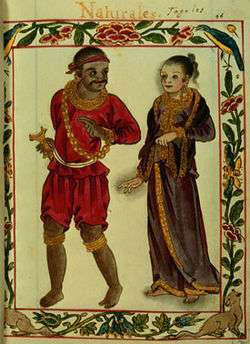Kalantiaw
| Kalantiaw | |
|---|---|
| Title | Rajah Kalantiaw the third head of Panay Island |
| Description | Code of Kalantiaw creator |
| Gender | Male |
| Region | Negros and Panay |
Datu Kalantiaw (Rajah Bendahara Kalantiaw) (sometimes spelled Kalantiao) is considered by the Visayans as the third head of Panay (an island in Visayas with four provinces: Aklan, Antique, Capiz and Iloilo). He is a mythical Filipino character who was said to have created the first legal code in the Philippines, known as the Code of Kalantiaw, in 1433.
The code was contained in one of five manuscripts acquired from Jose E. Marco by the Philippine Library in 1914.[1] The manuscript, Antiguas Leyendas is the only source of the Code. Historian William Henry Scott asserted in his PhD thesis, Critical Study of the Prehispanic Source Materials for the Study of Philippine History that there is no evidence that any Filipino ruler by the name of Kalantiaw ever existed or that the Kalantiaw penal code is any older than 1914. Scott successfully defended the thesis in 1968 before a panel of eminent Filipino historians which included Teodoro Agoncillo, Horacio de la Costa, Marcelino Foronda, Nicolas Zafra, and Gregorio Zaide. The thesis was published by University of Santo Tomas Press Press in 1968.[2]
The historian Josue Soncuya published a Spanish translation of the code in 1917, and wrote about it in his book Historia Prehispana de Filipinas (Prehispanic History of the Philippines). Soncuya concluded that the Code had been written for Aklan because of the presence of two Aklanon rather than Hiligaynon words in the text, and the words Aklan, Panay Island were added to later versions of Soncuya's translation (viz. "Echo en al año 1433–Calantiao–3° regulo").[3]
Some Filipinos, both scholars and non-scholars, continue to believe that the Code of Kalantiaw and the datu/chieftain who supposedly promulgated these laws actually existed. In a 2001 International conference presentation on ‘The Philippine Judicial System’, Dr. Raul Pangalangan, Dean, College of Law from the University of the Philippines said, "[...] all ancient written laws of the Filipinos were lost with the exception of the Code of Maragtas and the Code of Kalantiaw, both from Panay Island."[4] During the Philippine House of Representative 2nd Regular Session in August 2008, Congressman Aurora Cerilles referred to the signing of the Code of Kalantiaw in Panay saying, "That is why there is the so-called ‘The Code of Kalantiaw,’ where a person called Marikudo signed a treaty with Sumakwel".[5]
National Historical Institute (NHI) Resolution No. 12 in 2004 declared "[...] that Code of Kalantiao/Kalantiaw has no Valid Historical Basis”. This resolution called for: (1) the official affirmation that the Kalantiaw Code is a twentieth-century fraudulent work by Jose Marco, (2) the President of the Philippines cease to honor retiring Supreme justices and other international dignitaries with the ‘Order of Kalantiaw’, and (3) the revoking of Executive Order 234, which declared the municipality of Batan, Province of Aklan as a national shrine.33 This NHI resolution was approved by the Office of the President in 2005 and taken into effect immediately, despite strong protests from the people of the province of Aklan.[6]
| Pre-hispanic History of the Philippines |
 |
|---|
| Barangay government |
| Ten datus of Borneo |
| States in Luzon |
| Luyag na Kaboloan (Pangasinan) |
| Ma-i |
| Kingdom of Maynila |
| Namayan |
| Kingdom of Tondo |
| States in the Visayas |
| Kedatuan of Madja-as |
| Rajahnate of Cebu |
| States in Mindanao |
| Rajahnate of Butuan |
| Sultanate of Sulu |
| Sultanate of Maguindanao |
| Sultanate of Lanao |
| Key figures |
| Sulaiman II · Lakan Dula · Sulaiman III · Katuna |
| Tarik Sulayman · Tupas · Kabungsuwan · Kudarat |
| Humabon · Lapu-Lapu · Alimuddin I · Muedzul Lail Tan Kiram |
| History of the Philippines |
| Portal: Philippines |
See also
Notes
- ↑ Scott 1984, p. 104.
- ↑ Scott 1984, p. 134 and back cover notes.
- ↑ Scott 1984, p. 132.
- ↑ Pangalangan 2001, p. 1
- ↑ Justiniano 2011, p. 8
- ↑ Justiniano 2011, p. 7
References
- Scott, William Henry (1984), Prehispanic Source Materials for the study of Philippine History, New Day Publishers, ISBN 971-10-0226-4
- Justiniano, Maureen (2011). "Jose E. Marco's Kalantiaw Code: Implications for Philippine Historiography and Filipinos' Historical Consciousness". Explorations: a graduate student journal of southeast asian studies. University of Wisconsin - Madison. 11 (1).
- Pangalangan, Raul C. (March 2001). "Overview of the Philippine Judicial System" (PDF). Asian Law Series (5).